JENNIFER GREENHALGH, PGS
The Campos and Santos basins are two major hydrocarbon basins along Brazil’s Atlantic Margin. The oldest syn-rift discovery underlying the extensive regional salt horizon was 1978’s Linguado field in the Campos basin, although, subsequently, the pre-salt remained an unattractive, difficult target. Not until 2006, and the discovery of the Tupi/Lula field in the Santos basin (the largest pre-salt discovery to date in the Brazilian margin), was the scale of the potential reserves appreciated. Since the success of Tupi field, exploration and production of pre-salt plays has added enormously to Brazil’s offshore reserves, as subsequent pre-salt discoveries have followed in both the Campos and Santos basins.
In contrast, the pre-salt play thought to underlie Angola’s offshore basins has been slower to progress. Despite proven hydrocarbon potential, the pre-salt plays have not been fully explored and developed. In 1992, the Falcao-1 well penetrated the pre-salt, encountering ~600 m of organic-rich lacustrine shales and encountering reservoir-quality carbonates. In 1996, the Baleia-1 well targeted the pre-salt and discovered an estimated 1-billion-boe, in-place volume in a dolomitic reservoir (Henry et al., 2010). Only more recently have more concerted exploration campaigns been undertaken, with the 2011 discoveries of Cameia, by Cobalt, and of Azul by Maersk. In the light of increased recognition of the potential reserves that lie in the pre-salt section of the Kwanza-Benguela basins, and the laterally equivalent sediments of the Namibe basin, a major regional survey was required using the latest seismic acquisition technology to unlock our understanding of this region.
The PGS Angola MultiClient 2D was acquired in 2011 in association with state firm Sonangol. The survey was a long-offset GeoStreamer dual-sensor acquisition, with a cable length of 10 km towed at a 20-m depth, and providing a record length of 15 sec. The regional 2D grid lies over the offshore Kwanza-Benguela and Namibe basins, as can be seen in Fig. 1.
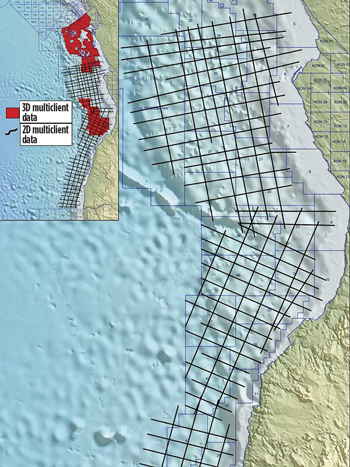 |
| Fig. 1. Map with location of the Kwanza-Benguela 2D survey and inset, map with location of PGS Angola dataset |
|
As the geology of the Kwanza-Benguela basin area is very complex, the velocity model-building was a key part of the PreSDM work. The confluence of two oceanic currents in the basin made a simple water velocity function unsuitable for the lines, so a variable water velocity was used. Anisotropy was incorporated throughout the model building stages. The sediment model, itself, was updated, using a variety of migration algorithms—Kirchhoff and Reverse Time migrations, both in anisotropic mode. The model was updated by picking RMO (residual moveout curves), using both offset and angle gathers. PGS’s proprietary tomography software was used to update the velocity model. The resulting changes in velocity were firmly constrained by the geology—a key to the success of the model building was interactive interpretation of the horizons after each iteration of the model update. PSDM processing of the Kwanza-Benguela basin area was completed in May 2012, while PSDM processing of the Namibe basin (a less geologically complex area) is anticipated to complete in August 2012.
REGIONAL GEOLOGY/PETROLEUM SYSTEM
Angola’s offshore area is part of the South Atlantic salt basin geological province. In West Africa, this extends from the southern margin of the Niger Delta in the north, to the Walvis Ridge volcanic high in the south (Brownfield & Charpentier, 2006). The offshore basins of these countries share similar structural and stratigraphic characteristics, due to their common origin during Late Jurassic to Early Cretaceous rifting of the proto-Atlantic. The common origin and development of these basins is also shared with those of Brazil, on the opposing conjugate margin. The geological history of these basins is commonly divided by basin development stages, each characterized by particular petroleum systems.
The syn-rift (pre-salt) stratigraphic phase is characterized by periods of basement extensional block faulting, which lead to the formation of a series of asymmetrical horst and graben basins. Within the graben basins, the earliest sediments to be deposited were continental in origin (Harris et al., 2004). At this time, thick sequences of non-marine (fluvial-lacustrine) sediments were deposited within narrow deep lakes, where conditions included a high clastic input, algal blooms, input of terrestrial plant detritus and anoxic bottom waters. This led to the formation of a world-class source rock, which lay in close proximity to the reservoir facies. Reservoir rocks range from conglomerates and sandstones shed from local horst blocks to lacustrine and fluviatile sandstones. It is likely that several phases of rift block-faulting took place (Karner & Driscoll, 1999), during each of which these conditions would become established.
As active rifting ceased, the early post-rift, or sag stratigraphic phase is characterized by the deposition of continental, fluvial and transgressive lagoonal rocks (Teisserenc & Villemin, 1990, Brownfield & Charpentier, 2006), containing both source rock and reservoir rock facies. The sag phase sediments of the Brazilian Conjugate Margin are of significant interest at the present time, due to the 2006 discovery of Lula field, the reservoir of which was a microbial carbonate reef deposited during the sag phase. This had developed on the top of a large structure comprising rifted basement blocks. Subsequent related discoveries, e.g. Jupiter field, have focused exploration activities on the sag phase sediments on both sides of the South Atlantic. The sag phase sediments were overlain by an evaporite sequence, which accumulated as a result of repeated cycles of marine incursions across the Walvis Ridge into a restricted basin, and their subsequent evaporation. This evaporite layer acts as a seal across the syn-rift petroleum system.
CONJUGATE MARGIN RECONSTRUCTION
New exploration strategies are being developed around the world, using the conjugate margin concept. Recent drilling success in the South Atlantic area has highlighted the fact that the geological model for successful discoveries will have an analog geological model across the conjugate margin. The advance of plate reconstruction models has further enhanced the understanding of the conjugate margin.
PGS is working with GETECH to study and utilize this new exploration concept. The aim is to focus on geological models associated with the conjugate margins and define the exploration fairways of the petroleum play across the South Atlantic. In the South Atlantic Conjugate Margin alone, PGS has access to 200,000 sq km of 3D seismic and 300,000 km of 2D seismic in Brazil, and 180,000 sq km of 3D and 35,000 km of 2D in West Africa. GETECH provides the Global Plate Model, which has information on basin geodynamics, juxtaposition of play elements, boundary conditions for palaeo-geographic mapping and reconstruction of exploration data (including seismic). The combination of the two will highlight proven conjugate margin geologic models and prospectivity.
Using the existing seismic data, global palaeo-reconstructions have been done, starting from the initiation of rifting, and displayed at different time intervals. Figure 2 shows the predicted plate locations at 122 Ma of the Campos and Santos basins of Brazil and their conjugate pairs, the Kwanza-Benguela and Namibe basins of Angola. The reconstructed location of the Angola 2D survey and significant pre-salt oil discoveries are also rotated and reconstructed back in time, to where their positions would have been at this time interval. Fixing the geological model at the time of deposition outlines the fairway of prospectivity across the conjugate margin.
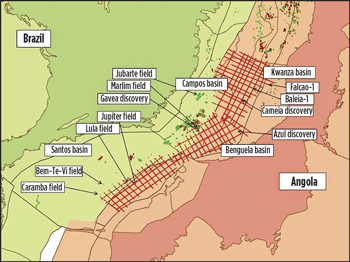 |
| Fig. 2. Conjugate Margin plate reconstruction at 122 Ma, with significant discoveries highlighted (Global Plate Model by Getech) |
|
PROSPECTIVITY
The initial screening of the completed MultiClient 2D PSDM survey shows an immediate uplift in the clarity of the imaging of the pre-salt section, when compared to the earlier full-stack PSTM processing. This is clearly illustrated in Fig. 3, where imaging of not only the base salt, but also much of the sedimentary succession and basement structures underlying the salt, was not previously possible. Across much of the PSDM survey, the base salt can now be clearly imaged. Underneath it, a sag phase package with bedding parallel to the base salt and thick sections of syn-rift are clearly visible. Lying under this sedimentary succession are the older pre-rift, faulted basement blocks. Their presence provides the underlying horst and graben structure for both the accumulation of syn-rift sediments and source rocks within the half-graben basins, and as a platform for the development of sag phase carbonate reservoirs along the horst highs.
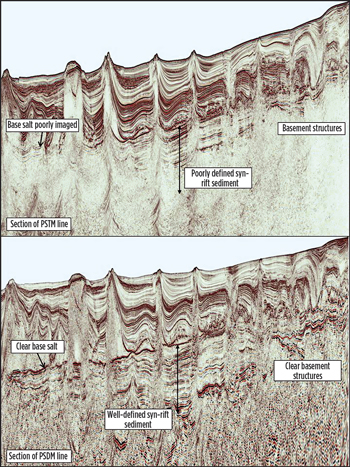 |
| Fig. 3. Example dip line, comparing original PSTM with final PSDM |
|
Figure 4 shows an example of a classic pre-salt or “Lula” type of structure. In the strike line section, the base salt is clearly imaged and flat, with a package of sag phase sediments displaying the same seismic geometry directly underlying it. Underneath the sag phase sediments, a syn-rift depositional package can be seen, whose steeply dipping bedding is seen to infill the palaeo-topography created between rifted Basement fault blocks. In the corresponding dip line section, the rifted basement block can be seen to form a high structure with a thick package of syn-rift sediment in a sub-basin to the west, and the overlying sag phase sediments draped over the Basement structure, which forms a significant trap. Amplitude variations are not expected within the seismic in this particular setting, and exploration efforts in this sedimentary unit have focused on targeting well-defined basement structures that are visible under the regional salt layer.
The structure illustrated in Fig. 4, and other examples within the extensive regional survey, show that there is a significant number of potentially prospective targets within the Kwanza-Benguela basin area. Being able to image the basement structures clearly allows them to be mapped, and then for their distribution and tectonic development to be better understood. The improved understanding that this allows assists in an improved recognition of the development of the syn-rift sedimentary depocentres, as well as prediction of the migration of hydrocarbons from these depocentres, and then in identifying the locations of potential hydrocarbon accumulations.
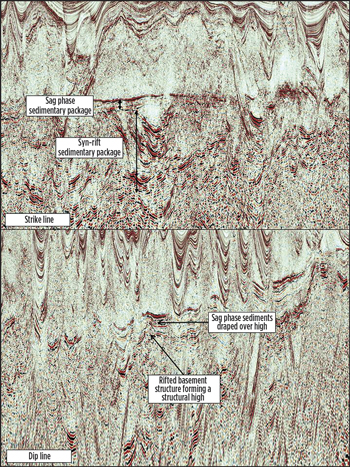 |
| Fig. 4. Example of an undrilled pre-salt lead on dip and strike lines |
|
Figure 5 shows a regional strike line that illustrates the importance of the regional scale. A broad basement structure is shown that demonstrates the control that the older extensional rift structures exert over the deposition of syn-rift source rocks within the deep graben structures. The same structure can also control reservoir distribution, both by clastic sediments onlapping onto its flanks and also by providing a palaeo-high upon which carbonate reef structures could develop. The areal extent of this structure is such that it is not possible to recognize its nature on a block-sized survey.
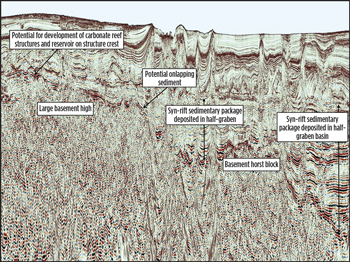 |
| Fig. 5. Strike line showing development of the regional basement structure and sedimentary depocentre |
|
CONCLUSIONS
The Angola MultiClient 2D Kwanza-Benguela basins survey acquired by dual-sensor streamer in 2011, and now fully PSDM processed, is already showing a significantly improved ability to image the basement, syn-rift and sag phase sediments that underlie the extensive salt layer. The regional nature of the survey allows an appreciation of the large-scale structures and sedimentary depocentres while also having sufficient resolution to identify prospect-level structures.
The depth migration of the regional survey across the Kwanza-Benguela and Namibe area is a step forward in assisting exploration, and understanding and de-risking of these potentially prolific hydrocarbon provinces. 
REFERENCES
1. Brownfield, M.E., and R. R. Charpentier, R.R., “Geology and total petroleum systems of the West-Central Coastal Province (7203),” West Africa: U.S. Geological Survey Bulletin 2207-B, 52 p., 2006.
2. Harris, N. B., K. H. Freeman, R. D. Pancost, T. S. White and G. D. Mitchell, “The character and origin of lacustrine source rocks in the Lower Cretaceous synrift section, Congo Basin, West Africa,” AAPG Bulletin, v. 88, no. 8, pp. 1163–1184, 2004.
3. Henry, S. G., L. Sebastio, N. Kumar, A. Sebastio and S. Venkatramen, “Tupi’s conjugate: New pre-salt plays in the Angolan offshore,” AAPG Search and Discover Article #90104, AAPG Annual Convention and Exhibition, Nov. 14, 2010.
4. Karner, G.D., and N. W. Driscoll N.W., “Tectonic and stratigraphic development of the West African and eastern Brazilian Margins: Insights from quantitative basin modelling, N. R. Cameron, R. H. Bate, and V. S. Clure, eds., The oil and gas habitats of the South Atlantic: Geological Society [London] Special Publication, v. 153, p. 11–40, 1999.
The author
JENNIFER GREENHALGH is principal geologist with PGS Reservoir in London. Dr. Greenhalgh has been with PGS since 2006, and is currently a member of the Multiclient Africa team. She graduated from University College London, with a PhD in geology in 2002. |
|







